Analysis of Rogers Communications Inc. Firm/Internal Environment
Analyzing the corporate strategy and business-functional strategies of Rogers Communications Inc. in the telecommunications industry.
55 Pages10150 Words371 Views
Added on 2023-05-30
About This Document
This report analyzes the strategies that Rogers Communications Inc. utilizes, resulting in their growing success. It examines their primary and secondary value chain activities, operations, and a comparative analysis between Rogers and two other competitors. The report also looks at the company's operating outlets and annual revenue.
Analysis of Rogers Communications Inc. Firm/Internal Environment
Analyzing the corporate strategy and business-functional strategies of Rogers Communications Inc. in the telecommunications industry.
Added on 2023-05-30
ShareRelated Documents
Running head: ANALYSIS OF ROGERS’ COMMUNICATION
Analysis of Rogers Communications Inc. Firm/Internal Environment
Company: Rogers Communications Inc. (Telecommunications industry)
By: Madawi Abunayyan #0510024 (madawiabunayyan@trentu.ca)
Majed Abunayyan #0478092 (majedabunayyan@trentu.ca)
Gillian Snelling #0580580 (gilliansnelling@trentu.ca)
Meghan Timewell #0587823 (meghantimewell@trentu.ca)
Analysis of Rogers Communications Inc. Firm/Internal Environment
Company: Rogers Communications Inc. (Telecommunications industry)
By: Madawi Abunayyan #0510024 (madawiabunayyan@trentu.ca)
Majed Abunayyan #0478092 (majedabunayyan@trentu.ca)
Gillian Snelling #0580580 (gilliansnelling@trentu.ca)
Meghan Timewell #0587823 (meghantimewell@trentu.ca)

1ANALYSIS OF ROGERS’ COMMUNICATION
Table of Contents
Introduction......................................................................................................................................3
Introduction to the Value Chain Analysis.......................................................................................4
PRIMARY VALUE CHAIN ACTIVITIES....................................................................................8
OPERATIONS................................................................................................................................8
Comparative analysis between Rogers and two other competitors like..........................................9
Company Operating Outlets............................................................................................................9
SECONDARY VALUE CREATING ACTIVITIES....................................................................22
R&D / NEW PRODUCT DEVELOPMENT................................................................................25
CORPORATE LEADERSHIP......................................................................................................27
Telus Market Capitalization..........................................................................................................35
SUMMARY...................................................................................................................................36
References......................................................................................................................................37
Table of Contents
Introduction......................................................................................................................................3
Introduction to the Value Chain Analysis.......................................................................................4
PRIMARY VALUE CHAIN ACTIVITIES....................................................................................8
OPERATIONS................................................................................................................................8
Comparative analysis between Rogers and two other competitors like..........................................9
Company Operating Outlets............................................................................................................9
SECONDARY VALUE CREATING ACTIVITIES....................................................................22
R&D / NEW PRODUCT DEVELOPMENT................................................................................25
CORPORATE LEADERSHIP......................................................................................................27
Telus Market Capitalization..........................................................................................................35
SUMMARY...................................................................................................................................36
References......................................................................................................................................37
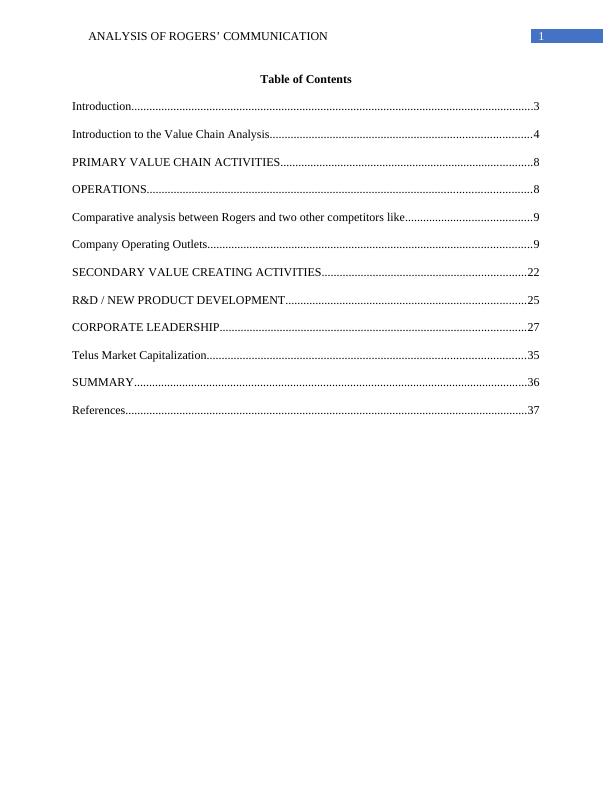
2ANALYSIS OF ROGERS’ COMMUNICATION
Executive Summary
Rogers is of the largest, most powerful communications companies in Canada. This
report uses annual reports to ascertain the strategies that Rogers utilizes, resulting in their
growing success. Their operating outlets that consist of wireless, cable, media and business
solutions have each been considered as a percentage of total revenue, the largest percentage
being from wireless operations. This operations information, combined with distribution
logistics, marketing and sales, and customer service are all part of the primary value chain
activities. As for the secondary value chain activities, this will include human resources
management, research and development, and corporate leadership. In researching these sections,
it has been discovered the direct correlation between employee morale resulting in higher
productivity. Rogers offers many benefits for employees, which boosts production, which
reflects in a rising rate of revenue per employee. Spending on research and development proves
to be an asset for Rogers, as technology is full of endless opportunities for innovation.
The information in each section has been further examined as a comparison between
Rogers and other industry leaders in the Canadian communication industry. The intention is to
see where Rogers stands regarding their strengths and weaknesses when considering the
competition. Through the research conducted, it has been determined that Rogers effectively use
the value chain activities to identify which items are the most necessary for them to have a
superior product compared to the industry.
Executive Summary
Rogers is of the largest, most powerful communications companies in Canada. This
report uses annual reports to ascertain the strategies that Rogers utilizes, resulting in their
growing success. Their operating outlets that consist of wireless, cable, media and business
solutions have each been considered as a percentage of total revenue, the largest percentage
being from wireless operations. This operations information, combined with distribution
logistics, marketing and sales, and customer service are all part of the primary value chain
activities. As for the secondary value chain activities, this will include human resources
management, research and development, and corporate leadership. In researching these sections,
it has been discovered the direct correlation between employee morale resulting in higher
productivity. Rogers offers many benefits for employees, which boosts production, which
reflects in a rising rate of revenue per employee. Spending on research and development proves
to be an asset for Rogers, as technology is full of endless opportunities for innovation.
The information in each section has been further examined as a comparison between
Rogers and other industry leaders in the Canadian communication industry. The intention is to
see where Rogers stands regarding their strengths and weaknesses when considering the
competition. Through the research conducted, it has been determined that Rogers effectively use
the value chain activities to identify which items are the most necessary for them to have a
superior product compared to the industry.
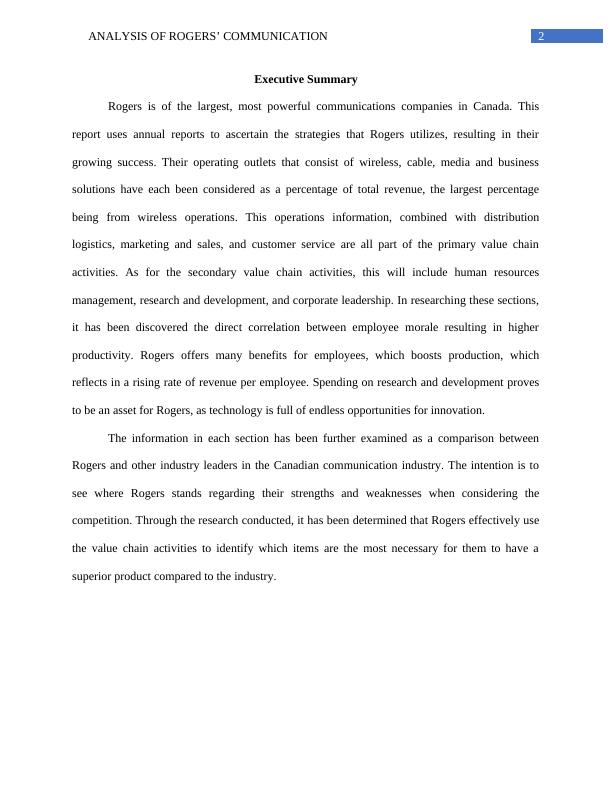
3ANALYSIS OF ROGERS’ COMMUNICATION
Introduction
Edward Samuel (Ted) Rogers Jr, Joel Aldred at Toronto in the year 1960, established
Roger communication. Basically, the two men bought the first Canadian radio station. After
some time in operation, they teamed up with Bassett and Eaton Families in order to expand the
business. Luckily, Roger communication secured the private television license after a series of
unsuccessful bidding. This enabled them to expand their broadcasting services.
The company accrued a lot of debts due to the high running costs of the TV and radio
business. The situation prompted them to further partner Aldred and the Bassett and Eaton
families. Unfortunately, the licensing commission declined to renew their broadcasting license.
The situation forced the Aldred and the Bassett and Eaton families to withdraw from the
partnership (Dearing, & Singhal, 2018). After some years of successful maneuvers, the business
made drastic improvements and war ranked the largest cable companies in Canada.
The company later engaged in telecommunication business through the purchase of Cantel
shares. By so doing, it diversified its areas of operations; Rogers Cable, Rogers Wireless, and
Rogers Media. Unfortunately, despite its diversified nature, Roger telecommunication has
continued to reduce the number of its employees. Notably,it has had an average of 25500
employees for the last three years. Additionally, its approximate annual income and revenue
are$1300 and $14000 respectively (“Roger Communications SWOT Analysis,” 2018). Rogers
controls a market share of roughly 29% of the telecommunication services in Canada.
Rogers communication started humbly and diversified with time to other areas of
operation including the wireless communication. Markedly, it has grown to the level of
competing with other leading companies in the same industry such as TELUS. Rogers has
Introduction
Edward Samuel (Ted) Rogers Jr, Joel Aldred at Toronto in the year 1960, established
Roger communication. Basically, the two men bought the first Canadian radio station. After
some time in operation, they teamed up with Bassett and Eaton Families in order to expand the
business. Luckily, Roger communication secured the private television license after a series of
unsuccessful bidding. This enabled them to expand their broadcasting services.
The company accrued a lot of debts due to the high running costs of the TV and radio
business. The situation prompted them to further partner Aldred and the Bassett and Eaton
families. Unfortunately, the licensing commission declined to renew their broadcasting license.
The situation forced the Aldred and the Bassett and Eaton families to withdraw from the
partnership (Dearing, & Singhal, 2018). After some years of successful maneuvers, the business
made drastic improvements and war ranked the largest cable companies in Canada.
The company later engaged in telecommunication business through the purchase of Cantel
shares. By so doing, it diversified its areas of operations; Rogers Cable, Rogers Wireless, and
Rogers Media. Unfortunately, despite its diversified nature, Roger telecommunication has
continued to reduce the number of its employees. Notably,it has had an average of 25500
employees for the last three years. Additionally, its approximate annual income and revenue
are$1300 and $14000 respectively (“Roger Communications SWOT Analysis,” 2018). Rogers
controls a market share of roughly 29% of the telecommunication services in Canada.
Rogers communication started humbly and diversified with time to other areas of
operation including the wireless communication. Markedly, it has grown to the level of
competing with other leading companies in the same industry such as TELUS. Rogers has
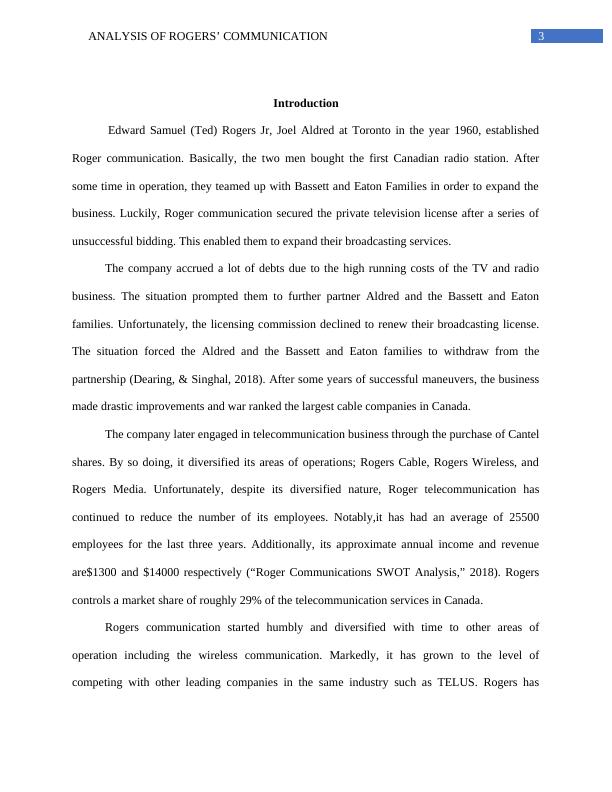
4ANALYSIS OF ROGERS’ COMMUNICATION
banked on research and development. It also has a clearly defined leadership owing it the fruitful
operations.
Part III - Firm or Internal Environment
Introduction to the Value Chain Analysis
Rogers Communication founded in Toronto in 1960 (Hally, 2016). The company was
founded by Edward Samuel (Ted) Rogers Jr, Joel Aldred (Hally, 2016). These two men started
by buying the rights to Canada’s first FM radio station, CHFI (Hally, 2016). Later that year the
Bassett and Eaton Families partnered with the company, after a bidding war they won the license
for CFTO the first private television station in Toronto (Hally, 2016). Three years after Rogers
start broadcasting on January 1, 1961, Rogers entered the AM radio station (Hally, 2016).
During the 1970s, the Rogers company had gone into immense debt due to the high cost
associated with the running of a radio and TV station business (Hally, 2016). Ted Rogers after
learning about the infant industry of Cable television once again partnered with Aldred and the
Bassett and Eaton families were granted a license for Toronto, Brampton, and Leamington,
Ontario (Hally, 2016). In 1969, the recently formed Canadian Radio-television and
Telecommunications Commission (CRTC) at the time was concerned with media ownership
(Hally, 2016). This regulatory board informed Rogers that they would only renew their Cable
licenses if the Bassett and Eaton families where no longer involved with the company (Hally,
2016). Even though this would put Ted Rogers into more debt, he was able to pay the 50 percent
share that the families had (Hally, 2016). Over the coming years the cable TV business grew, and
in 1980 Rogers went from the sixth largest cable company into the largest due to the acquisition
of two of the biggest cable companies in Canada (Hally, 2016).
banked on research and development. It also has a clearly defined leadership owing it the fruitful
operations.
Part III - Firm or Internal Environment
Introduction to the Value Chain Analysis
Rogers Communication founded in Toronto in 1960 (Hally, 2016). The company was
founded by Edward Samuel (Ted) Rogers Jr, Joel Aldred (Hally, 2016). These two men started
by buying the rights to Canada’s first FM radio station, CHFI (Hally, 2016). Later that year the
Bassett and Eaton Families partnered with the company, after a bidding war they won the license
for CFTO the first private television station in Toronto (Hally, 2016). Three years after Rogers
start broadcasting on January 1, 1961, Rogers entered the AM radio station (Hally, 2016).
During the 1970s, the Rogers company had gone into immense debt due to the high cost
associated with the running of a radio and TV station business (Hally, 2016). Ted Rogers after
learning about the infant industry of Cable television once again partnered with Aldred and the
Bassett and Eaton families were granted a license for Toronto, Brampton, and Leamington,
Ontario (Hally, 2016). In 1969, the recently formed Canadian Radio-television and
Telecommunications Commission (CRTC) at the time was concerned with media ownership
(Hally, 2016). This regulatory board informed Rogers that they would only renew their Cable
licenses if the Bassett and Eaton families where no longer involved with the company (Hally,
2016). Even though this would put Ted Rogers into more debt, he was able to pay the 50 percent
share that the families had (Hally, 2016). Over the coming years the cable TV business grew, and
in 1980 Rogers went from the sixth largest cable company into the largest due to the acquisition
of two of the biggest cable companies in Canada (Hally, 2016).
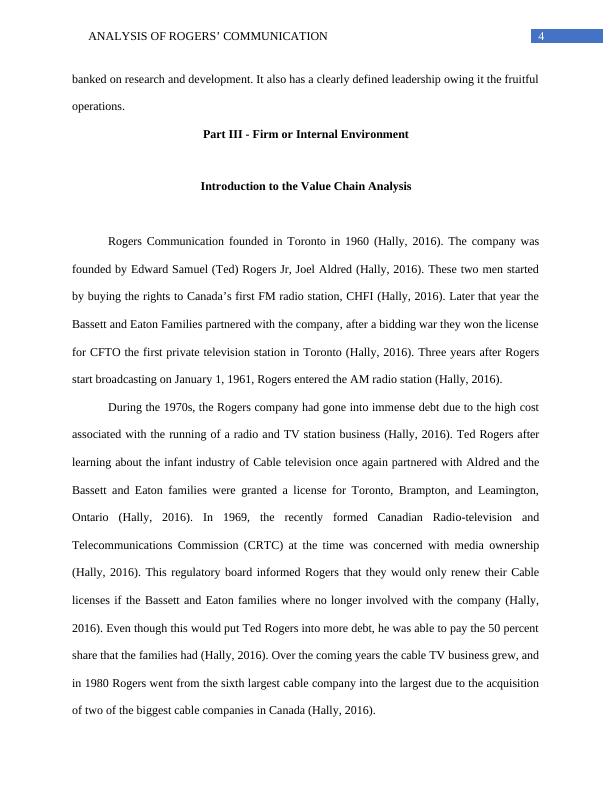
5ANALYSIS OF ROGERS’ COMMUNICATION
In the 1980s, Ted Rogers recognized the potential of cellular/wireless and Telephone
industry (Hally, 2016). Rogers bought 25 percent shares in Cantel. Cantel became the first
company to set up a Canada-wide cellular telephone network (Hally, 2016). In 1986 the newly
named Rogers Communications Inc. gained operational control and two years later gained full
control of Cantel (Hally, 2016). While the company has continued to grow in the 1990s the
company was close to collapsing due to its $5-million debt load (Hally, 2016). In 1999,
Microsoft, AT&T, and British Telecom invested $2 million into the company easing the concern
of the impending collapse (Hally, 2016). Since then the Rogers company has continued to grow
and has become Canada's largest telecommunication company (Hally, 2016).
Currently, Rogers Communication is a diverse media company that has three significant
lines of business, Rogers Cable, Rogers Wireless, and Rogers Media. Rogers cable and wireless
sectors are the largest within Canada, and the media sector is Canada’s premier collection of
media assets (Rogers, 2017). While Rogers is one of the most diverse communication and media
company compared to Telus and Bell has the lowest number of employees. As displayed in
Figure 1.1 we can also see the Rogers has been cutting back on the number of employees its
employees.
In the 1980s, Ted Rogers recognized the potential of cellular/wireless and Telephone
industry (Hally, 2016). Rogers bought 25 percent shares in Cantel. Cantel became the first
company to set up a Canada-wide cellular telephone network (Hally, 2016). In 1986 the newly
named Rogers Communications Inc. gained operational control and two years later gained full
control of Cantel (Hally, 2016). While the company has continued to grow in the 1990s the
company was close to collapsing due to its $5-million debt load (Hally, 2016). In 1999,
Microsoft, AT&T, and British Telecom invested $2 million into the company easing the concern
of the impending collapse (Hally, 2016). Since then the Rogers company has continued to grow
and has become Canada's largest telecommunication company (Hally, 2016).
Currently, Rogers Communication is a diverse media company that has three significant
lines of business, Rogers Cable, Rogers Wireless, and Rogers Media. Rogers cable and wireless
sectors are the largest within Canada, and the media sector is Canada’s premier collection of
media assets (Rogers, 2017). While Rogers is one of the most diverse communication and media
company compared to Telus and Bell has the lowest number of employees. As displayed in
Figure 1.1 we can also see the Rogers has been cutting back on the number of employees its
employees.
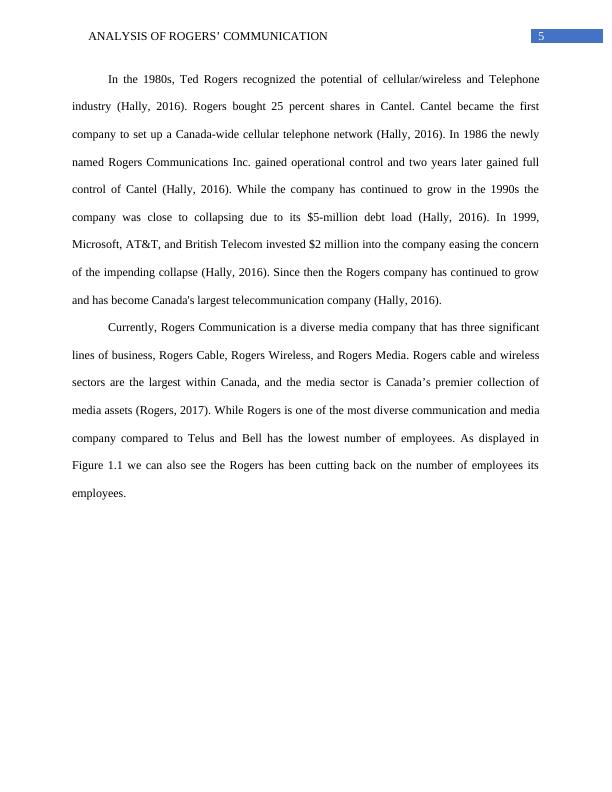
6ANALYSIS OF ROGERS’ COMMUNICATION
Figure 1.1: Number of active employees, working at Telus, Bell, and Rogers in 2015, 2016, and 2017. Retrieved
from Telus, Bell, and Rogers 2015-2017 Annual Reports.
PRIMARY VALUE CHAIN ACTIVITIES
OPERATIONS
An organization's business activities and operations are an important aspect that
determines their success. Organizations operations focuses on creating an environment that
supports partnership, direct and foreign investment, organization and growth of the business,
productivity, efficiency, and advancement in business activities (Kazam, 2009).Rogers
communications operations are based on wireless, cable, business solution and media, and
almost all the sales that the business takes part in occur regionally in Canada.
Figure 1.1: Number of active employees, working at Telus, Bell, and Rogers in 2015, 2016, and 2017. Retrieved
from Telus, Bell, and Rogers 2015-2017 Annual Reports.
PRIMARY VALUE CHAIN ACTIVITIES
OPERATIONS
An organization's business activities and operations are an important aspect that
determines their success. Organizations operations focuses on creating an environment that
supports partnership, direct and foreign investment, organization and growth of the business,
productivity, efficiency, and advancement in business activities (Kazam, 2009).Rogers
communications operations are based on wireless, cable, business solution and media, and
almost all the sales that the business takes part in occur regionally in Canada.
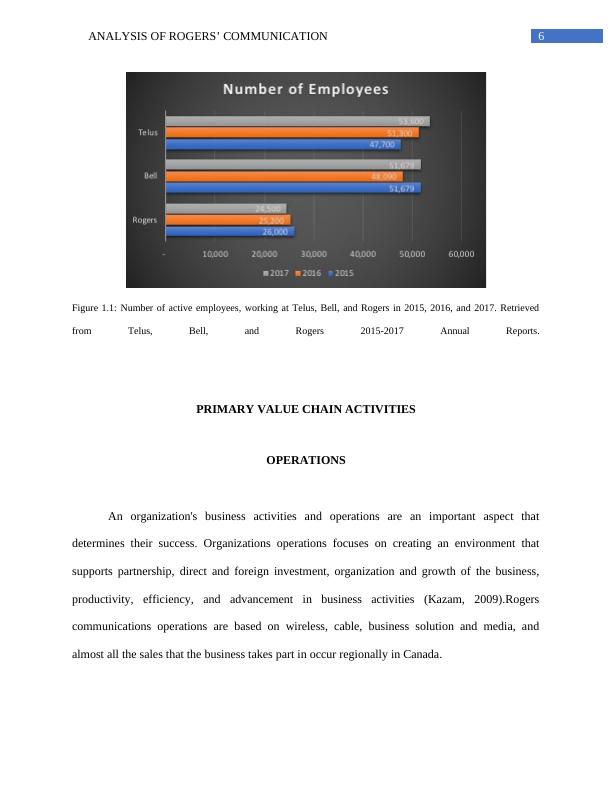
7ANALYSIS OF ROGERS’ COMMUNICATION
Comparative analysis between Rogers and two other competitors like
Among most of the recognizable telecommunication brands of Canada Bell has already
occupied a prestigious place due to their superior quality of internet services along with
rendering diversified products. As per 2015 annual data, the company has grabbed $2.730 billion
CAD as their net income. Telus is one of the most recognizable places occupied a predominant
place in Canadian market. This organization is occupied CA$ 46.68 stock price in the current
market. Voice entertainment, healthcare, video, IPTV television is the core product with which
Telus is dealing in order to maintain their market sustainability.
By comparing the revenue of Rogers, Bell, and Telus companies in Figure 1.2 we can tell
that even though Rogers cable and wireless are the largest in Canada. It is not the company that
has the highest revenue or net income. This can also be viewed in Figure 1.3 that depicts the net
income of Rogers, Bell, and Telus for the past three years.
Figure 1.2: Revenue amounts for Telus, Bell, and Rogers for the years 2015-2017. Retrieved from Telus, Bell, and
Rogers 2015-2017 Annual Reports. Exact numbers can be found in Appendix II
Comparative analysis between Rogers and two other competitors like
Among most of the recognizable telecommunication brands of Canada Bell has already
occupied a prestigious place due to their superior quality of internet services along with
rendering diversified products. As per 2015 annual data, the company has grabbed $2.730 billion
CAD as their net income. Telus is one of the most recognizable places occupied a predominant
place in Canadian market. This organization is occupied CA$ 46.68 stock price in the current
market. Voice entertainment, healthcare, video, IPTV television is the core product with which
Telus is dealing in order to maintain their market sustainability.
By comparing the revenue of Rogers, Bell, and Telus companies in Figure 1.2 we can tell
that even though Rogers cable and wireless are the largest in Canada. It is not the company that
has the highest revenue or net income. This can also be viewed in Figure 1.3 that depicts the net
income of Rogers, Bell, and Telus for the past three years.
Figure 1.2: Revenue amounts for Telus, Bell, and Rogers for the years 2015-2017. Retrieved from Telus, Bell, and
Rogers 2015-2017 Annual Reports. Exact numbers can be found in Appendix II
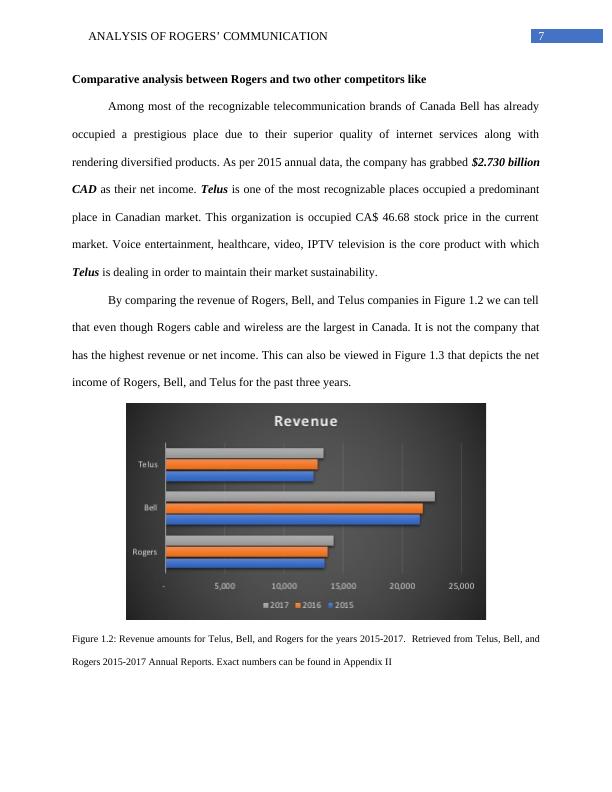
End of preview
Want to access all the pages? Upload your documents or become a member.
Related Documents
Introduction of Rogers Wirelesslg...
|8
|2602
|298
Analysis of Corporate Strategy and Business-Functional Strategies of Rogers Communications Inclg...
|24
|5685
|146
Enterprise Performance Managementlg...
|7
|2293
|16
International Market Eentry Strategylg...
|7
|1116
|14
Case Study Analysis and Reportlg...
|21
|7812
|46
Strategies and Environmental Constraints for Rogers Wirelesslg...
|10
|2369
|121
